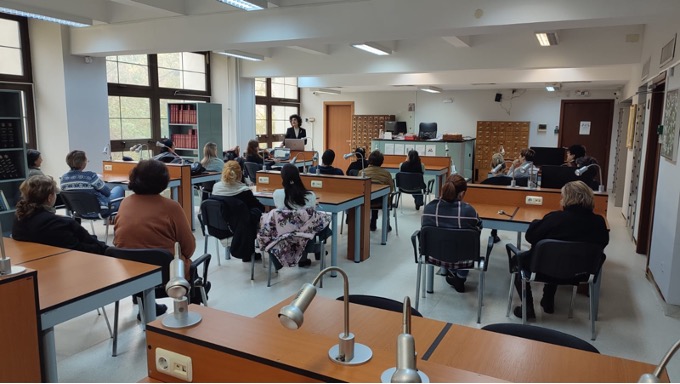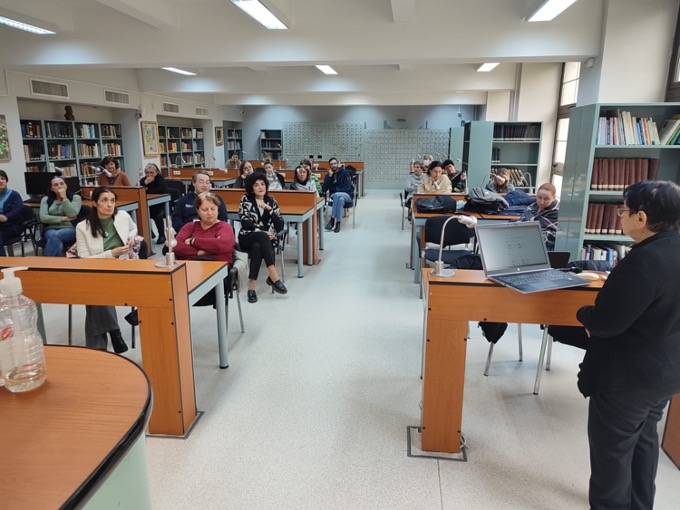During four days, from 27th to 30th November 2023, 24 cultural heritage experts from the main cultural institutions in Bucharest that own collections of books and manuscripts, including two regional museums and one national museum located outside Bucharest, attended the SafeCult Training Course on Disaster Risk Management for Written Cultural Heritage. The course was organized by the Romanian Association i-CON in collaboration with the Romanian Academy Library (BAR) for two professional categories, Disaster Risk Experts and Supervisors, responsible for the practical implementation of disaster risk management strategies at their cultural institution level.
The perceived vulnerability of written cultural heritage to the increasing severity and frequency of disaster events as a result of climate change, natural disasters and conflicts is increasing. The internal surveys conducted at the beginning of the SafeCult project found that even though the cultural heritage experts recognised the danger of natural/climate-change-induced disasters, they did not always consider them a priority risk factor for the sites they managed. In Romania, despite the high earthquake risk, the survey revealed a number of experiences and perceptions from heritage professionals on matters such as geological hazard, climate change adaptation, emergency preparedness and facing. This fragmented and in-deficit of adequate information and capacity requires an accelerated training effort to improve the specialized curricula of heritage professionals and support the institutions for managing and reducing disaster risk. In this context, the implementation of the Training Course “Disaster Risk Management for Written Cultural Heritage” achieve the capacity-building programme of SafeCult designed to strengthen the capacities of Participating institutions and countries to protect written cultural heritage at risk of disasters.
The course, inspired by the rich literature and experience of previous European and international projects tackling disaster risk management of cultural heritage, has been developed thanks to the experiences pooled by the SafeCult project Partners and stakeholders active in the field of written cultural heritage protection at risk who participated in the activities organised by this pioneering project.
Building on the main assumption of SafeCult, that the disaster risk supervisors and cultural heritage experts must work together, the Training Course organized in Bucharest was proposed in two sessions of 2-days the first one held on 27-28 November was dedicated to training the Disaster Risk Supervisors and the second one on 29-30 November was dedicated for training the disaster Risk Experts.
The interdisciplinary groups of trainees were allowed to create interactive training and promote a proactive debate on the inclusion of written cultural heritage in risk management processes. The program of the Training Course was customized to achieve the following objectives:
- Improve the specialized curricula of heritage professionals and develop their ability to face emergency.
- Help to build community- and national-level preparedness.
- Integration of written cultural heritage into disaster risk management (DRM) theory and practice.

The first day of training dedicated to Disaster Risk supervisors started with the Presentation of SafeCult project and its relevance in the national context given by Dr. Gabriela Dumitrescu, Head of the Collections at BAR, then focused on the key concepts of disaster risk reduction and management for written cultural heritage WCH (Dr. Elena Badea, i-CON Association). The trainees were asked to list the activities they perform or should perform to mitigate a hazard, to be prepared against, to respond and to recover after a hazard. After defining these key elements of disaster management, Dr. Cristina Carsote (i-CON Association) exercised with the trainees how to apply these concepts to the specific context (internal and external) of their cultural institutions in order to analyse and evaluate the specific risk exposition and main risk drivers. This thought-provoking approach allowed the participants to learn and solve different tasks.

The second day was even more involving for the trainees: firstly, a Disaster Management Plan was introduced by Dr. Luminita Kovari (BAR) and the trainees were asked to customize it for the specific case of their institutions. Based on these customized DMPs, the discussions were conducted by Cristina Carsote and Elena Badea to illustrate how to prepare for emergencies and how to face emergencies. Thus, the trainees went through the disaster risk management cycle that helped them feel more prepared to prevent, mitigate and respond to major disasters, successfully limiting damage to property, the environment and people.
The first day of the Training Course dedicated to Disaster Risk Experts focused on the SafeCult Disaster Management Approach for written cultural heritage presented by Elena Badea and continued with the illustration of the main elements for elaborating a Disaster Management Plan (Luminita Kovari, BAR). The trainees were asked to customize the DMP for their cultural institutions. Then, Cristina Carsote taught the trainees how to perform effective risk prioritisation . The last topic was interactively conducted, involving the participants who were then asked to prepare a Checklist. The second day was entirely dedicated to the main Disaster Scenarios deepened within SafeCult project and to the objects/collection assessment in an emergency. In this very proactive session, some of the experiences of the trainees were collected and will be added to the list of SafeCult good practices.
The answers to the evaluation questionnaires delivered to the trainees indicated that, overall, the course objectives were achieved. The vast majority of participants expressed satisfaction with the training’s content and delivery method, independently of their professional background. Independently of their domain, conservation-restoration, management and research, they valued the opportunity to share ideas and insights with colleagues from diverse backgrounds. The questionnaire results validated both the content of the SafeCult Training Course and the proactive way of delivering the specialized knowledge and strongly advocated for implementing specific training in Romania on how to deal with written cultural heritage protection in emergencies in line with European standards.

